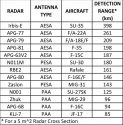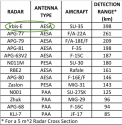Zool
Junior Member
There are two pertinent points worth emphasizing. First is the idea of mating Russian platform to French missile with Israeli ECM in between. This is not a recipe I believe is technically sound even if by some miracle Russia agrees or the French is willing to go along. I think this offers an insight on how disjointed and myopic India’s procurement approach is when deciding on aircraft procurement. Realistically, India is stuck with whatever Russia can offer in terms of future prospect as long as it operates the SU-30MKI.
It is very unlikely to be Israeli ECM on an upgraded Su-30MKI package. Especially given the Indians will likely follow the Russian Su-30SM upgrade path closely for commodities of scale. Small possibility of an Indian system, but what I think realistic is the RWR would be Indian via their DR-118 program, and the ECM system would be the Russian SAP-518. Upgraded engines will cover the additional weight and power requirements that this and a new radar would require.
The second point is that a missile effective range is limited by the accompanying sensor range. For example, even if the Meteor can be integrated to the SU-30MKI its NO11M radar would not be able to take advantage of the Meteor’s extended range. In the recent border skirmish, the SU-30MKI was out-sticked by the F-16 due to a sensor/RCS combination. The NO11M while supposedly has impressive detection is not what it seems when examined in detail. I will use the border exchange example with the F-16 to demonstrate this point
I think the H035 Irbis, which is what I expect to be the upgrade radar for the Su-30SMs and Su-30MKIs, would be more than capable of tracking and locking for a Meteor class of BVR missile to a range exceeding that of the RBE2-AESA on the latest Rafales. But as I've come to understand, this is unlikely in the extreme from the perspective of both France and Russia as previously discussed.
According to public records, the NO35 has a slightly better performance than the NO11M and I will use its data since I am more familiar with the underlying details. Source :
The NO35 has a detection range of 200kms against a 3 M2 RCS This however needs to translate to a meaningful level in its exchange with the F-16 which has an RCS of 1 M 2 against the SU-30MKI which has a RCS of between 10 to 15 M2. The excel sheet below provides the details of the conversion.
What should be noted is that the impressive detection number of the NO35 is based on a 50 % probability of detection unlike Western radars that use 80 % PD. I am also assuming that the F-16 used by the PAF was the Block 52 which has a AN/APG-68 radar. I am not sure whether it has the better ranged (V) 9 and so I have used both in the analysis. Radar lock is based on tracking range and not detection and this has to be further adjusted. The net result is that the F-16 would have been able to secure a radar lock on the SU-30MKI at around 100 kms (due to its higher RCS) and according to public records it was around this distance that the AIM-120C 5 was released. In contrast, it is not likely that the SU-30MKI was able to lock onto to the F-16 beyond 80 kms and that was what happened although the blame was placed on the limitation of the R-77. As I said before, even if the SU-30MKI was integrated with a Meteor at that time the end result would be the same as the accompanying sensor was the limiting factor. In summary, sensor, missile and relative RCS matters and the SU-30MKI has a big RCS disadvantage.
I don't want to get too lost in the weeds here so I'll try to follow your overall point and keep it related to India: When discussing Radar comparisons (and why I say H035 Irbis would be more than capable of launching a 200km BVR), we have pretty good information on detection ranges, but track and lock ranges are all secret. Anything you find will be a guesstimate at best.
The Russians describe the H035 Irbis as a hybrid ESA, X-Band Radar using a single high power amp transmitter (PESA), versus low power distributed transmitters (AESA). So you can't compare T/R modules since one is not distributed, but you can still look at peek power outputs and array sizes (dictated by the aircraft nose and ability to reduce electronic package sizes). Again, without getting into the weeds of pure radar discussion we can safely say PESA typically has a larger peek output, however AESA has much more flexibility in scanning wavelengths, reduced signal attenuation, steering and ECCM, due to its distributed nature. There are pros and cons, but overall a pure AESA design is the ideal solution, which Russia has on its Su-57 (N036 Byelka). Russia's probable issue is manufacturing good yield T/R modules without a major domestic electronics base like the US or Japan or China. Which does not mean they cannot do it, but there will be a very high cost. And budget is a big issue.
:

Yes the Flankers have a large RCS, but they also have a large nose for a large array, a large combat radius on internal fuel, very good maneuverability and other offsets as compared to say, the Rafale. ECM/ECCM conditions aside, I see no issue with an upgraded Su-30MKI firing the latest in BVR missiles using the H035.
A couple of good reads/reference material for the H035 as well as one I dug up from when Rafale switched to AESA (RBE2 was originally PESA):
F-35 is not a realistic option for the same reason that Turkey was removed from the program. If I was a betting person, I would not rely on the prospect of a timely AMCA given India’s historical performance. That leaves the SU-57 and India has a better insight than anyone outside Russia. The reason they pulled out is because they don’t think it was up to expectation. That leaves the Rafael as a decent stopgap.
No its not, for reasons pertaining to the S-400s and other operational constraints that would be placed upon India in the aircraft's usage and data sharing. That's why I believe a Su-57 purchase is in the cards within the next 10 years or so. The pullout was primarily in the context of development work and technology sharing (or lack of) for the money India would have needed to contribute. With their existing capital requirements and minimal return on tech that they could then port over to the AMCA program, they bailed. Off the shelf purchase is absolutely on the table however.
Finally I see quite a bit in this forum the idea of AWACs providing off board targeting solutions. I am not convince that this is technically feasible given that AWACs operate the frequency bands that do not have sufficient resolution beyond providing bearing information. I would like to see technical papers arguing how this would actually happen.
I cannot point to an authoritative source for this but it has been talked about for a long time (as a capability the USAF had), that targeting updates could be sent from AWACS via the Link network. I believe it goes back to the AIM-54, and this evolved on the Naval side into CEC (Cooperative Engagement Capability) with ship based combat systems.
**Also, a correction/update on the India MWF or Tejas 2.0. I refreshed some of my info on this program since my previous posts were based on knowledge I had from the last year or so. Although design work has still not been made public (or started?), word is that it is no longer envisioned as a dual engine aircraft, but still an iteration of Tejas MK1A, with the addition of canards.**

